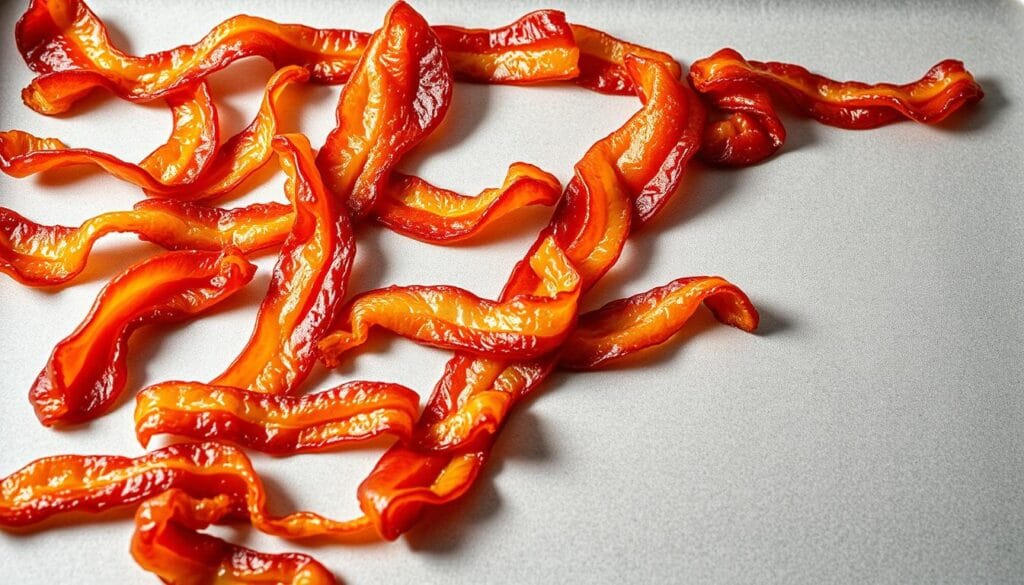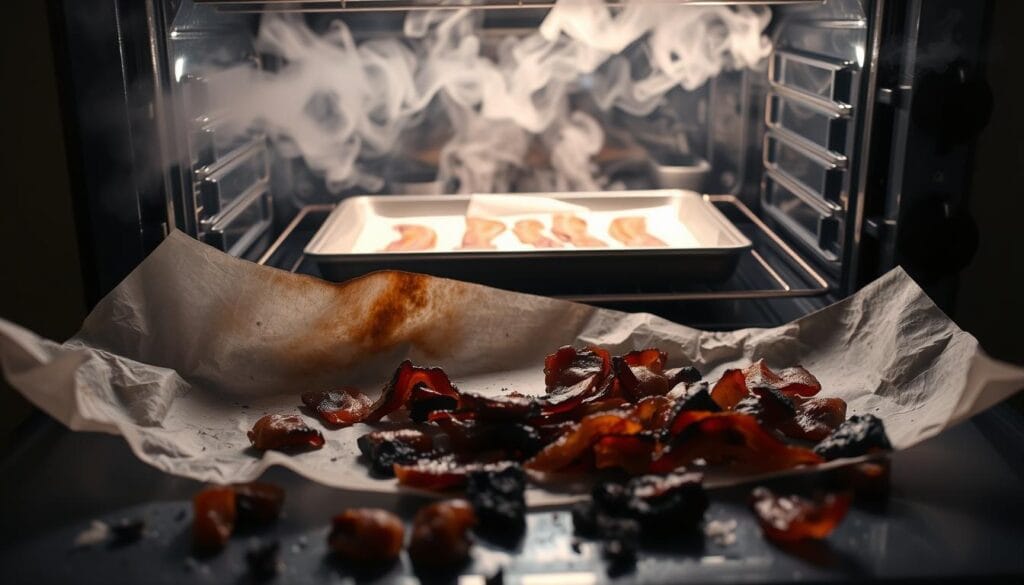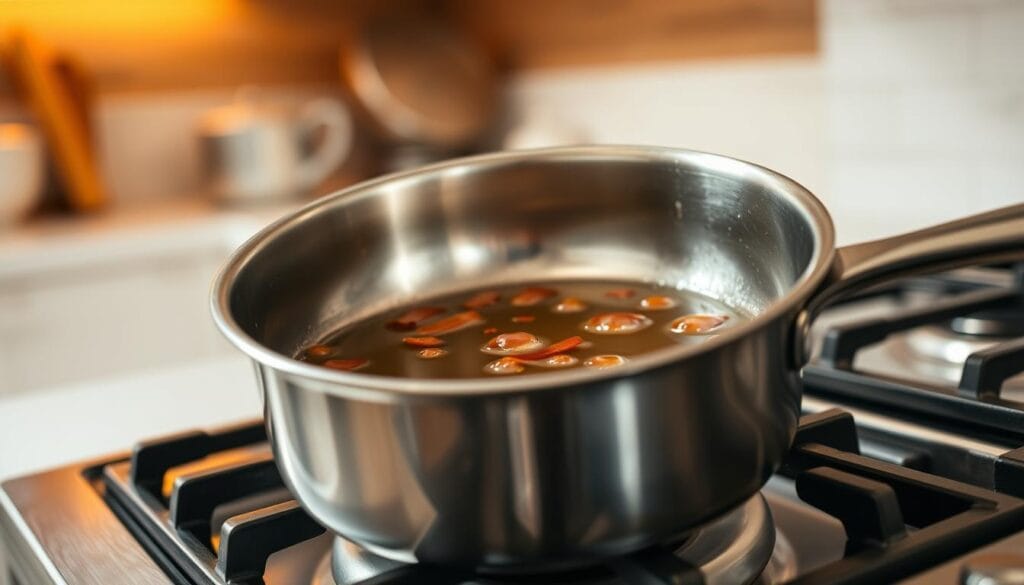HowToCook.news – Your Ultimate Guide to Delicious Cooking!
Oven-Baked Bacon: A Simple Method for Delicious Results
Oven-Baked Bacon: A Simple Method for Delicious Results
Table of Contents
Oven-Baked Bacon: A Simple Method for Delicious Results

Cooking bacon in the oven has changed breakfast for many in the United States. This method makes cooking bacon easy and stress-free. It’s loved by both professional chefs and home cooks for its perfect results every time.
Using the oven to cook bacon means no messy splatters or uneven cooking. Just a simple baking sheet and your oven can turn raw bacon into crispy, golden goodness. It’s a breakfast treat that will wow everyone.
Key Takeaways
- Oven-baked bacon provides more consistent cooking results
- Reduces kitchen mess and grease splatter
- Allows for hands-off cooking technique
- Creates evenly crispy bacon strips
- Works with various bacon thickness levels
Why Oven-Baked Bacon is Superior to Stovetop Methods
Oven-baked bacon stands out as the best choice. It changes how we make breakfast, beating stovetop methods in many ways.
Benefits of Even Cooking Distribution
Oven baking ensures every bacon strip cooks perfectly and consistently. It’s great for bacon lovers because it:
- Eliminates hot spots that cause uneven cooking
- Makes all strips crispy at the same level
- Prevents curling and keeps texture even
Time-Saving Advantages
Oven methods make cooking bacon easy and quick. You can cook many strips at once, saving time. This makes making breakfast faster and more efficient.
Reduced Kitchen Cleanup
Oven-baked bacon also means less mess in the kitchen. It keeps grease on a lined baking sheet, which means:
- Less splatter on the stovetop
- Less grease to clean up
- Protection for your cooking surfaces
Professional chefs agree: oven baking is the superior bacon cooking method for home kitchens.
Essential Equipment for Perfect Oven-Baked Bacon
To bake bacon well, you need the right tools. Choosing the right equipment is key for even cooking and easy cleanup.
A rimmed baking sheet is crucial for oven-baked bacon. Stainless steel or aluminum sheets are best. They distribute heat evenly and stop grease from dripping.
- Rimmed baking sheet (prevents grease spills)
- Wire cooling rack (optional, allows fat drainage)
- Parchment paper or aluminum foil (simplifies cleanup)
- Tongs for safe bacon handling
- Thick oven mitts for protection
A wire rack is great for crispy bacon. It lets bacon cook evenly and get crispy all over.
Parchment paper or aluminum foil makes cleanup easy. Just line your baking sheet before adding bacon. This stops bacon from sticking and makes cleaning up a snap.
Heavy-duty baking sheets are a pro tip. They handle high heat well. Look for ones with strong edges for stability.
How to Cook Bacon in the Oven: Step-by-Step Guide
Cooking bacon in the oven is a game-changer. It makes bacon crispy with little effort. This method avoids messy stovetop splatters and cooks bacon evenly every time.
To cook bacon in the oven, follow a few easy steps. Knowing the right oven temperature and technique makes breakfast better.
Preparing Your Baking Sheet
Choose the right baking tools for perfect bacon:
- Use a rimmed baking sheet to catch bacon grease
- Line the sheet with aluminum foil for easy cleanup
- Optional: Place a wire rack on the baking sheet for extra crispiness
Arranging Bacon Strips
How you arrange bacon is key for even cooking:
- Lay bacon strips in a single layer without overlapping
- Leave slight space between each strip for consistent heat circulation
- Trim longer strips if necessary to fit the baking sheet
Temperature and Timing Guidelines
Getting the bacon just right needs careful temperature control:
- Standard bacon thickness: 375°F for 15-20 minutes
- Thick-cut bacon: 350°F for 20-25 minutes
- Check bacon at 10-minute mark and rotate pan if needed
Mastering oven-cooked bacon takes patience and attention. Your effort will pay off with crispy, evenly cooked bacon every time.
Selecting the Right Type of Bacon for Oven Baking
Choosing the perfect bacon for baking can make a big difference. Not all bacon types do well when baked in the oven.
Different bacon varieties have unique qualities that affect cooking:
- Thickness matters: Thick-cut bacon needs longer cooking times
- Cured vs. uncured options change flavor and texture
- Smoked or applewood-style bacon adds to the taste
When picking bacon for oven baking, think about these important factors:
- Slice thickness (thin, regular, thick-cut)
- Fat content distribution
- Curing method
- Potential flavor additives
Premium bacon brands like Nueske’s or Applewood Smoked often give better results. Look for bacon with balanced fat marbling for even cooking and crispiness.
Try different bacon types to find your favorite. Each variety adds its own twist to baking bacon in the oven.
Temperature Settings and Cooking Times Explained
Mastering the oven bacon recipe means knowing the right cooking temperature and techniques. The correct temperature can make your bacon go from bland to amazing. This ensures it’s always crispy and delicious.
The quality of oven-baked bacon depends on several important factors. These include the cooking temperature and the bacon’s texture and taste. Professional chefs say specific temperature ranges are key for the best results.
Recommended Temperature Ranges
Experts agree that the best oven-baked bacon is cooked between 375°F and 425°F. These temperatures ensure even heat and effective fat rendering.
- Low and Slow (375°F): Ideal for thick-cut bacon, allowing even cooking
- Medium Heat (400°F): Perfect for standard bacon strips
- High Heat (425°F): Best for extra-crispy bacon lovers
Cooking Duration Based on Thickness
The thickness of bacon affects cooking time. Thin-cut bacon cooks in 12-15 minutes. Thick-cut bacon takes 15-20 minutes at the same temperature.
Signs of Perfectly Cooked Bacon
Knowing when bacon is perfectly cooked involves looking for certain signs. Look for:
- Golden-brown color
- Crisp edges
- Consistent texture without burnt spots
- Slight curl at the edges
By following these temperature guidelines, you can make restaurant-quality oven-baked bacon at home.
Preventing Smoke and Maintaining a Clean Oven
Cooking bacon in the oven can be messy if you’re not ready. Smoke and grease splatter are common problems. Knowing the right tips can help you avoid mess and keep your kitchen clean.
To reduce smoke when cooking bacon, follow these tips:
- Use a rimmed baking sheet with a wire rack to elevate bacon strips
- Line the bottom of the baking sheet with aluminum foil for easy cleanup
- Choose bacon with less fat content to minimize grease splattering
Managing grease is key when oven baking bacon. Professional chefs suggest using parchment paper or a silicone baking mat to catch excess fat and prevent smoking. These tools act as a barrier, making cleanup much easier.
Temperature control is also important to avoid smoke. Cooking bacon at a moderate temperature (around 400°F) helps render fat evenly. This prevents dangerous grease splatters. Don’t overcrowd the baking sheet, as it can cause uneven cooking and more smoke.
Pro tip: Always keep a close eye on your bacon and have a fire extinguisher nearby when experimenting with oven baking techniques.
After cooking, clean your oven quickly to avoid grease buildup. A mix of baking soda and water can remove stubborn bacon residue without harsh chemicals.
Achieving the Perfect Crispiness Level
Making the perfect crispy bacon recipe is all about mastering oven-baked bacon. Bacon lovers know that texture is key. With the right techniques, you can turn a simple breakfast into a feast.
Getting the bacon just right depends on a few important things. Home cooks can easily learn these tricks. They help you make bacon that’s both crispy and delicious.
Texture Variables to Consider
Everyone likes their bacon a little differently. Knowing this lets you adjust your cooking to suit their taste:
- Soft and Chewy: Shorter cooking time, lower temperature
- Medium Crisp: Standard cooking duration and heat
- Extra Crispy: Extended cooking time, higher temperature
Adjusting Cook Time for Desired Results
Your success with crispy bacon depends on temperature and timing. Thinner slices cook faster, while thicker ones need more care to avoid burning.
- Thin-cut bacon: 12-15 minutes at 400°F
- Regular-cut bacon: 15-18 minutes at 400°F
- Thick-cut bacon: 18-22 minutes at 375°F
Pro tip: Always use a rimmed baking sheet. Keep an eye on your bacon in the last few minutes to avoid overcooking.
Storage and Reheating Methods for Oven-Baked Bacon
Learning to cook bacon in the oven is just the start. It’s also important to know how to store and reheat it. This keeps the bacon’s flavor and crispiness just right.
To store bacon for a short time, put it in the fridge in an airtight container. Wrap it in paper towels to soak up extra grease. This way, your bacon will stay tasty for 4-5 days.
- Refrigerate within 2 hours of cooking
- Use shallow, sealed containers
- Place paper towels between bacon layers
Freezing is a great way to keep bacon for longer. Put bacon strips in a freezer-safe bag with parchment paper in between. Frozen bacon stays good for up to 3 months.
When reheating, be careful to keep the bacon crispy. The oven is the best way to do this:
- Preheat oven to 350°F
- Place bacon on a wire rack
- Heat for 5-10 minutes
- Check for desired crispiness
Pro tip: Avoid microwave reheating, which can make bacon soggy and destroy its delightful crunch.
Common Mistakes to Avoid When Baking Bacon
Learning how to bake bacon in the oven can be tricky. Even skilled cooks can make mistakes that ruin their bacon. These errors can make your crispy bacon less perfect.

It might seem easy to cook bacon in the oven, but there are common mistakes. Knowing these can help you make perfect bacon every time.
Temperature Control Challenges
Getting the oven temperature right is key. If it’s off, your bacon won’t cook evenly. This can make your bacon not as good as you want it to be.
- Avoid setting temperatures too high, which causes rapid burning
- Prevent undercooked bacon by maintaining consistent oven temperature
- Use a reliable oven thermometer for accurate heat monitoring
Spacing and Arrangement Problems
How you place the bacon matters a lot. The right way to arrange it can make a big difference in taste and texture.
- Never overcrowd the baking sheet
- Ensure strips do not overlap
- Leave sufficient space between bacon pieces
Pro tip: Use a wire rack on your baking sheet to allow fat to drip away and promote even cooking.
Healthier Options: Reducing Fat Content
Bacon lovers can still enjoy their favorite food with healthier cooking methods. By using smart techniques, you can make bacon less fatty while keeping it tasty.
Professional chefs suggest several ways to make bacon leaner:
- Use a wire rack to elevate bacon during baking
- Choose center-cut or lower-sodium bacon varieties
- Blot excess grease with paper towels immediately after cooking
- Select nitrate-free or organic bacon options
Draining excess fat is key for healthier bacon. By placing bacon on a sloped surface or rack, gravity helps remove extra grease. This simple trick can cut fat content by up to 40%.
For those looking to cook bacon with fewer calories, here are more tips:
- Trim visible fat before cooking
- Use lower oven temperatures (around 375°F)
- Cook smaller portions to control serving sizes
Mindful bacon eating lets health-conscious people enjoy this favorite without giving up on nutrition.
Creative Ways to Season Oven-Baked Bacon
Turning simple oven bacon into a masterpiece starts with creative seasoning. The right spices can make your crispy bacon recipe stand out. It turns a classic breakfast item into a gourmet delight.
Seasoning bacon opens up a world of flavors. It’s more than just salt and pepper. The trick is knowing how different spices work with bacon’s rich taste.
Sweet and Savory Combinations
Try these exciting seasoning ideas for unique flavors:
- Maple Brown Sugar: Sprinkle brown sugar and a touch of maple syrup before baking for a sweet-savory twist
- Bourbon and Black Pepper: Brush bacon with bourbon and crack fresh black pepper for a sophisticated flavor
- Honey Sriracha: Combine honey and sriracha for a spicy-sweet glaze that caramelizes beautifully
Spice Blends for Enhanced Flavor
Try these spice combinations to transform your oven bacon recipe:
- Smoky Paprika and Garlic Powder
- Cayenne and Brown Sugar Mix
- Italian Herb Blend
- Cajun Seasoning
“The secret to great bacon is not just in the cooking method, but in the creativity of your seasoning.” – Culinary Chef
Apply seasonings before baking and watch closely to avoid burning. Each spice blend can make a unique crispy bacon recipe. It will surprise and delight your taste buds.
Using Leftover Bacon Grease: Tips and Ideas

Bacon grease is a treasure in the kitchen. It can make your cooking better. Instead of throwing it away, use it in new ways.
Storing bacon grease is key. Strain it through a fine-mesh sieve or cheesecloth to get rid of solids. Then, put it in a clean glass jar and chill it. This way, it can last up to three months, perfect for many recipes.
- Sauté vegetables for added depth of flavor
- Replace butter or oil in cornbread recipes
- Create a rich base for salad dressings
- Season cast iron skillets
- Enhance the taste of roasted potatoes
Experts say to use bacon grease carefully because of its fat. A little goes a long way in bringing intense flavor to your dishes.
| Cooking Application | Recommended Amount |
|---|---|
| Sautéing Vegetables | 1-2 tablespoons |
| Cornbread Recipes | 2-3 tablespoons |
| Salad Dressing Base | 1 tablespoon |
Trying out bacon grease can make your meals special. Always store it right and use it in small amounts for the best results.
Troubleshooting Common Oven-Baked Bacon Issues
Cooking bacon in the oven can sometimes present challenges, but with the right techniques, you can overcome most common problems. When preparing oven-cooked bacon, home cooks often encounter several issues that can affect the final result.
Uneven cooking is a frequent concern when learning how to cook bacon in the oven. To address this problem, consider these key solutions:
- Use a rimmed baking sheet with a wire rack for better air circulation
- Rotate the baking sheet halfway through cooking
- Ensure bacon strips are not overlapping
Grease management becomes crucial during oven-baked bacon preparation. Excessive grease can lead to smoke and messy cleanups. Prevent this by:
- Lining the baking sheet with aluminum foil
- Using parchment paper for easy cleanup
- Placing a layer of paper towels underneath the bacon
“Perfect bacon is all about technique and attention to detail.” – Professional Chef
When bacon sticks to the baking sheet, try these quick fixes for your oven-cooked bacon:
- Use a non-stick baking sheet
- Apply a light cooking spray before placing bacon
- Let bacon cool slightly before removing
Temperature control plays a critical role in achieving crispy, evenly cooked bacon. Stick to a consistent oven temperature between 375-400°F for the best results. Watch your bacon closely during the last few minutes of cooking to prevent burning.
Environmental Considerations and Energy Efficiency
Baking bacon at home is not just tasty—it’s also good for the planet. Modern ovens use less energy, which helps save electricity. Cooking at a lower temperature, like 375°F, uses even less energy but still makes crispy bacon.
Being green in the kitchen starts with smart cooking. Cooking multiple bacon strips at once on a big baking sheet saves energy. Using ceramic or cast-iron sheets keeps the heat in, letting you cook at a lower temperature and save energy.
Going green with bacon goes beyond cooking. Buying bacon from local farms cuts down on emissions from transportation. Reusing bacon grease for cooking reduces waste and saves resources, making your bacon prep more eco-friendly.
These steps help the environment and make cooking more efficient. By watching energy use and waste, you help the planet while making tasty meals.
FAQ
What temperature is best for cooking bacon in the oven?
For oven-baked bacon, aim for 375°F to 400°F. This ensures even cooking and crispiness. Thicker bacon might start at 350°F for better results.
How long does it take to cook bacon in the oven?
Cooking time depends on bacon thickness and crispiness. Thin bacon takes 15-20 minutes, thick bacon 20-25 minutes. Always check and remove when crispy.
Do I need to use a baking rack when cooking bacon in the oven?
A baking rack is recommended but not required. It helps bacon get crispy and reduces fat. Use parchment paper or foil if you don’t have a rack.
How can I prevent bacon from smoking in the oven?
Use a rimmed baking sheet to catch grease. Avoid overcrowding and place the rack in the middle. Lowering the oven temperature or using lower-fat bacon can help. Line the oven bottom with foil to catch drips.
Can I cook frozen bacon directly in the oven?
Thawing bacon is best for even cooking. But, you can cook frozen bacon. Add 50% more time and separate slices for even cooking.
What’s the best way to store leftover cooked bacon?
Cool bacon and store in an airtight container or sealed bag in the fridge. It lasts 4-5 days. Freeze for up to 1 month. Use parchment paper between slices to prevent sticking.
How can I make bacon healthier when cooking in the oven?
Use a baking rack to drain grease. Choose leaner bacon and blot with paper towels. Turkey or center-cut bacon are good options for less fat.
Can I add seasonings to my bacon before baking?
Yes! Try black pepper, brown sugar, maple syrup, cayenne, or herbs like rosemary. Be careful with sugar-based seasonings, as they can burn. Apply them in the last 5-10 minutes.




